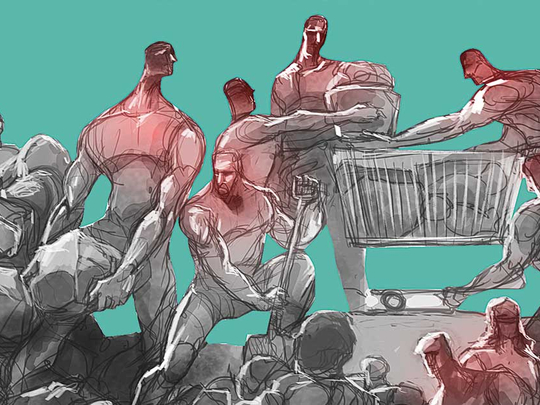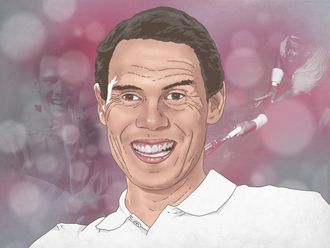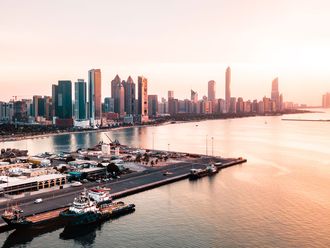
When the earthquake rattled this mountain capital last Tuesday, a five-storey office and apartment block round the corner from my home collapsed into a mountain of rubble, burying computer programmers, salesmen, secretaries. Right away, a handful of neighbours approached the wreckage, calling to see if anyone was alive and removing debris. Within hours, the group had swelled into the hundreds, joined by volunteers from across the city arriving by foot, truck and bicycle.
The volunteers shovelled rubble into buckets and cleared it from the scene in human chains. Firefighters, civil defence workers and finally soldiers arrived and laboured in unison with the civilians. At intervals, they would shout for people to be silent and raise their fists as they listened for the sounds of survivors. Hundreds more volunteers organised to supply water, food and tools as the force worked through the night.
This immense human effort, shown in the pictures of ordinary men and women sweating with spades, running with wheelbarrows, passing stretchers over their heads will surely be the lasting image of the 7.1 magnitude tremor that struck Mexico less than two weeks after a more distant 8.1 earthquake. It is a story of tragedy, but also of solidarity and hope.
“I felt I had to do something,” said Sergio Fragoso, a 31-year-old music producer, who came on a borrowed bike to toil at the site for 16 hours straight, his determination conquering his exhaustion. “I thought about what it would be like if it was me trapped under there. I would want people to help.”
Similar scenes were repeated at dozens of collapsed buildings across the battered capital as thousands of volunteers worked nonstop. Their efforts paid off, with more than 50 people rescued by the end of Wednesday, the mayor announced. On Thursday morning, workers used jackhammers to break up the last concrete blocks left at the building near my home. The entire office block had been cleared in less than two days, an incredible physical feat.
The effort was all the more impressive considering the scale of the devastation. Electricity and phone lines were down in much of the city, streets were blocked by debris and broken glass, and it was difficult to move anywhere. People were scrambling to find their own loved ones and get them to hospitals. I saw a man running through the street with an unconscious girl in his arms, another stumbling with a bleeding head into an ambulance. Many abandoned their cracked homes, fearing they also could collapse. But despite people’s own problems, they were ready to help those they didn’t even know. The roots of this human force lie in the earthquake that hammered Mexico City on exactly the same day 32 years earlier and killed thousands. Back then, civilian brigades also formed, although they took longer to mobilise and didn’t work alongside soldiers. It was an era of one-party rule, and the government tried to hide the scale of the damage and stop civilians from helping, worried that groups of good Samaritans in the streets could turn into political protesters.
The stories of those volunteers of 1985 feature strongly in the collective memory of Mexico City residents, known as “chilangos.” When the nightmare was relived, the new generation drew on this memory to act.
Lorenzo Meyer, a politics professor and author, joined the volunteer forces of 1985, and is proud that his grown-up children took to the streets this week. He described the stark differences between the two experiences. “Back then, we took almost two days to get to the buildings,” he said. “It was very hard to find information on what was happening. This time, there were text messages and social media feeds telling people where to go. And now the social energy is so strong, it’s impossible to repress.”
The brigades of 1985 had an impact on Mexican politics, Meyer said. Angry with a government they saw as uncaring, these empowered volunteers sought change. Many became activists fighting to end the hegemonic rule of the Institutional Revolutionary Party, or PRI. The capital became a bastion of opposition, and the PRI lost political control of it in 1997, before losing the presidency in 2000, after seven decades.
The latest mass mobilisation also could have a lasting political effect. The country now has multiparty democracy, and a more open media and civil society. But people are angry about officials embezzling millions of dollars, governors working with drug traffickers and brutal violence that haunts communities. The PRI returned to power in 2012 under President Enrique Pena Nieto, but he has suffered his own corruption scandals and his approval ratings have at times dropped to the teens.
A certain political reaction to the earthquake is already erupting. As it became clear that thousands had lost their homes from the tremor, people started online petitions calling for Mexico’s electoral institute to redirect hefty campaign finances for a presidential vote next year to earthquake relief. One of these petitions rapidly topped 1 million signatures.
A group created to support the petitions, FuerzaMexico, emphasizes the links between the political movements of past and present. “After the earthquake of 1985, Mexican civil society showed a power of solidarity and union without precedent; now we need it again,” it says on its page on the Change.org petition website.
A heightened awareness of people power could favour presidential hopeful Andres Manuel Lopez Obrador, who trumpets a populist anti-establishment discourse from the left. A former Mexico City mayor, he leads many opinion polls for the 2018 election as he calls for “el pueblo” to defeat a “mafia of power.” However, the advantage could swing to an independent candidate who offers an alternative to politicians and appeals to the many young professionals in the ranks of the volunteer brigades. Various personalities, including a TV anchor, an academic and a human rights defender, have expressed interest in running.
It could also strengthen Mexico’s resolve against the aggressive stance of the Trump administration, Meyer said. Around the rubble, the armies of volunteers often raise their fists and shout in unison, “Viva Mexico.”
“When we shout this, there is an implication that we are standing up to the hostile policies of the United States,” Meyer said. “After all of the recent insults, the humiliations, it is a way of reaffirming our pride.”
— New York Times News Service
Ioan Grillo is the author of Gangster Warlords: Drug Dollars, Killing Fields and the New Politics of Latin America and a contributing opinion writer.








